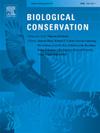气候变暖和管理行动之间的相互作用决定了保护区鸟类群落的变化
IF 4.4
1区 环境科学与生态学
Q1 BIODIVERSITY CONSERVATION
引用次数: 0
摘要
气候变暖对生物多样性的负面影响越来越大,使这一问题成为一个主要的保护问题。许多鸟类通过改变分布范围来应对变暖的温度,但这些变化往往滞后于温度的变化。保护区(PAs)可以促进这种转变,但越来越多的文献表明,并非所有的保护区都能同样促进气候变暖的响应,因为实现的管理行动可能不同。在这里,我们研究了水鸟群落变化作为对气候变暖的响应,并将其与欧盟Natura 2000保护区实施的保护项目的目标联系起来。我们将长期水鸟调查数据(即国际水鸟普查)与欧盟主要保护工具欧盟生命计划资助的保护数据结合起来。我们用群落温度指数来测量28年来群落热变化。我们发现群落对气候变暖的适应滞后于温度。然而,在以湿地生境为保护目标的地点,群落变化速度是没有生境保护的地点的两倍。与其他类型的物种保护相比,直接针对水鸟的保护不会导致群落变化的变化。研究结果表明,在管理层面上,针对群落栖息地的保护(而不是直接针对物种群)更有可能为群落适应气候变暖提供好处。该研究表明,目前不针对气候变暖对生物多样性影响的管理行动有可能支持物种应对气候变暖。然而,保护策略需要适应气候变暖带来的挑战。本文章由计算机程序翻译,如有差异,请以英文原文为准。
Interactions between climate warming and management actions determining bird community change in protected areas
Biodiversity is increasingly negatively affected by climate warming, making this issue a major conservation concern. Many bird species respond to warming temperatures by shifting distribution ranges, but these shifts often lag behind temperature changes. Protected areas (PAs) can facilitate such shifts, but a growing body of literature suggests that not all PAs facilitate climate warming responses equally, as realized management actions can differ. Here, we study waterbird community change as a response to climate warming in relation to targets of conservation projects implemented in Natura 2000 protected areas across the EU. We combine long-term waterbird survey data (i.e. International Waterbird Census) with data on conservation funded by the EU LIFE program, the main EU instrument for conservation. We used the community temperature index to measure thermal community changes over 28 years. We found community adjustment to climate warming lagged behind temperature. However, community change was twice as fast in sites were conservation was targeting wetland habitats compared with sites without habitat conservation. Targeting waterbirds directly did not lead to variation in community change compared with other types of species conservation. Our results imply that on the management level conservation targeting a community's habitat (rather than targeting the species group directly) is more likely to provide benefits for community adjustment to climate warming. This study demonstrates that management actions currently not targeting climate warming impacts on biodiversity, have the potential to support species responding to climate warming. However, conservation strategies need to be adapted to the challenges arising with climate warming.
求助全文
通过发布文献求助,成功后即可免费获取论文全文。
去求助
来源期刊

Biological Conservation
环境科学-环境科学
CiteScore
10.20
自引率
3.40%
发文量
295
审稿时长
61 days
期刊介绍:
Biological Conservation is an international leading journal in the discipline of conservation biology. The journal publishes articles spanning a diverse range of fields that contribute to the biological, sociological, and economic dimensions of conservation and natural resource management. The primary aim of Biological Conservation is the publication of high-quality papers that advance the science and practice of conservation, or which demonstrate the application of conservation principles for natural resource management and policy. Therefore it will be of interest to a broad international readership.
 求助内容:
求助内容: 应助结果提醒方式:
应助结果提醒方式:


